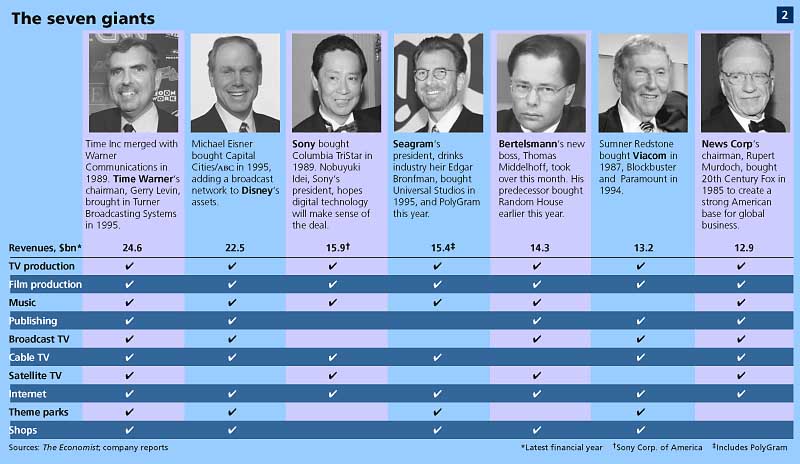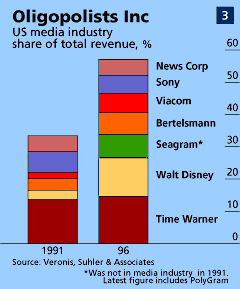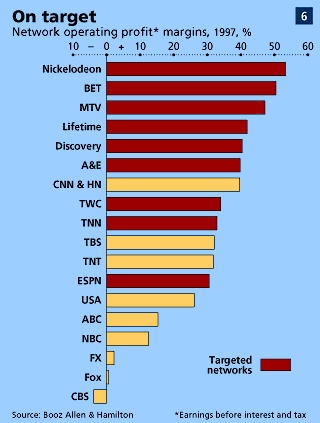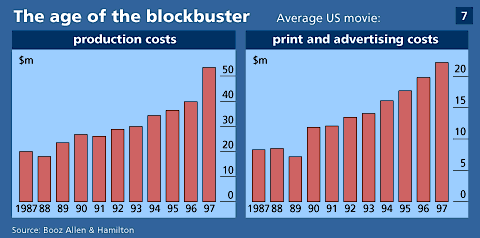| “TELEVISION? No good will come of it,”
said C.P. Scott, a great editor of the Manchester Guardian. “The word is half
Greek and half Latin.” But guessing television’s future was relatively easy. It
was one new form of distribution. Digital technology affects all existing ones, as well as
making new ones possible. It is like introducing the internal combustion engine into a
horse-drawn economy.

The three areas where its effect on distribution will be felt most are digital video (or
versatile) discs (DVDs), digital television and the Internet.

• DVDs. These are, in effect, CDs
with movies on them, and they will probably do for the film business what CDs
did for the record business: make some easy money as consumers and video rental shops
replace their stock of old, blurry tape with sharp new discs whose quality will not
degrade. All the studios are beginning to offer their movies on DVD.
“Man,” says Steve Heyer, president of Turner Broadcasting System, “what a
windfall.”

• Digital television. The technology—more channels
in the same amount of bandwidth—is the same everywhere, but its implications are
different in different markets.

In France, for instance, digital television spells multi-channel. Canal Plus has been
selling digital television to the French, rather successfully, since 1996. That is not
altogether surprising, since the choice is between one analogue pay-television channel or
60 digital ones.

In Germany, by contrast, Leo Kirch has found it a struggle to get people to sign up to his
DF1 digital platform. Pay television in Germany starts at a
disadvantage because it is competing against up to 12 free-to-air broadcast services. Mr
Kirch wanted to merge his digital offering with Premiere, the competing joint venture with
Bertelsmann and Canal Plus of which he also owns a stake; but the EU
vetoed the merger, and Canal Plus has left in disgust.

The British market is more competitive than the French, but less disastrous than the
German one. Digital television arrived on October 1st, courtesy of Mr Murdoch’s BSkyB. ONdigital, a service
put together by two of the big terrestrial broadcasters, launched its service on November
15th. The competition will be fierce, the demand uncertain. Since Britain already has a
good helping of pay channels, delivered by both cable and satellite, nobody knows whether
consumers will want to shell out for more. The most promising-looking application is
Sky’s near-video-on-demand service, which offers a range of films starting at
15-minute intervals. But to make the service attractive, Sky is having to subsidise the
installation of the necessary hardware in people’s houses.

In America, digital satellite services have been broadcasting since 1994. They serve
mostly people who live too far out in the sticks to be cabled, though they are also
popular with sports fanatics who will pay for innumerable obscure games. Cable operators
are beginning to offer digital services. According to Glen Britt, who runs Time
Warner’s cable operation, the most compelling offering is real video on demand,
provided costs can be squeezed down. “We’re very close now to being competitive
with rental. It could be in 2000.”

The broadcast networks are due to launch digital before the end of this year. They have to
offer high-definition television, because that was the quid pro quo for being given free
extra bandwidth to start digital services. The trouble is that the cable companies
(through which most people receive their broadcast television) say they will not carry the
signal because it takes up too much capacity. And even if they did, the price of an HDTV set—between $2,000 and $8,000—would put most people off.

• The Internet. Most of the entertainment companies have
spent freely on building a presence on the Internet, some more successfully than others.
All the sites get plenty of visitors, but nobody can work out how to make any money out of
them. “Like building shopping malls in the desert,” says James Murdoch,
Rupert’s youngest son, who is in charge of the new-media division of News Corp.

The exceptions have been the sports and news sites. For CNN, NBC, the BBC and every other big provider of
news, the Internet is both a threat (because it contains so many new sources of news) and
an opportunity (because it offers instant, low-cost global distribution). Now the
entertainment companies are changing their strategy. Time Warner seems to be giving up on advertising
revenue and is about to launch a big online retail outlet. At first this will sell only
Time Warner products, but it may branch out later. The company reckons it should have a
head start from an infrastructure that already bills people for $2 billion-worth of goods
sent by mail, and has a database of 60m customers.

Disney is getting deeper into the Internet than any of the other big companies. The
impetus comes from Mr Eisner, who has declared himself “obsessed by it.” On his
initiative, Disney has started employing some of the grandest names in information
technology as “Imagineering Fellows”: Alan Kay, one of the founding fathers of
the personal computer; Marvin Minsky and Seymour Papert, who co-founded the Artificial
Intelligence Laboratory at MIT in the mid-1960s; and Danny Hillis,
one of the inventors of parallel computing.

On the Internet, Disney already has Disney.com,
a standard entertainment company site with movie and television news. It also has Disney Blast, a
children’s magazine, which charges $5.95 a month, and an online shop that sells 2,000
Disney products. But the best of its sites is ESPN, a model of technology tailored
to please consumers. Baseball fans, for instance, can spend happy hours making it
calculate the number and frequency of their favourite player’s hits against anyone,
at any time, anywhere. Now Disney is building a portal—the sort of gateway to the
Internet that its owners hope will make money from advertising and commerce deals.

The general principle at work behind these particular uses of digital technology is known
by the dreadful name of disintermediation. Cheaper and easier distribution is bringing
producers and consumers closer together, making many of the middlemen redundant. This
creates big new opportunities for entertainment companies.

More capacity means more revenue from the same content. Everything-on-demand means greater
convenience for consumers, and hence bigger sales. Interactivity allows consumers to
follow up on something that tickles their fancy, by asking for more information or even by
ordering it. It already works on the Internet, and should be even more effective on
digital television, because television reaches so many more potential car buyers.

Retailers are under threat. Already those products of the entertainment business that have
traditionally been sold in shops—mainly books and music—are migrating fast to
the Internet. Take this a stage further, and producers will be able to cut out
intermediaries altogether and sell directly to consumers. Record companies are still
nervous of doing this, partly because they fear piracy and partly because they do not want
to antagonise powerful retailers. But the retailer’s margin is up for grabs.

Businesses that depend on the scarcity of information about consumers are in trouble,
because interactivity makes collecting such information much easier. For instance, the
information about their customers that book and music clubs painstakingly have to seek out
can be collected automatically on the Internet. This is what prompted Bertelsmann, the
world’s biggest book-club company, to put in a $200m bid for 50% of bookseller Barnes & Noble’s
site last month: the Internet had destroyed Bertelsmann’s old business model.

Businesses whose profits depended on controlling scarce distribution are also in trouble.
Broadcasting networks are feeling it first. The value of their main asset—the slice
of bandwidth they inhabit—is disappearing fast, and their business model is crumbling
as competition for advertising revenue grows. But pay-television networks, currently the
most profitable bits of the business in mature markets, will also suffer. Their profits
depend on a capacity shortage on the networks that keeps off newcomers. When there is no
shortage, competition will hot up and their profits will shrink.

Added attractions

Middlemen throughout the industry (and in many other industries too) can expect leaner
times. How much leaner depends on how much value they add to what they sell: the less, the
worse off they will be. As producers, the entertainment companies do add value to the
content they sell. In most video entertainment they add a lot by making the film. In sport
they generally do not add much, which is why they have to pay so much for sports rights,
why so many entertainment companies have seen fit to buy sports teams, and why Rupert
Murdoch is so determined to overcome political hostility to his bid for Britain’s
Manchester United. In music the entertainment companies add little, which makes the record
business much more vulnerable to the disintermediating effects of digital technology than
the video business.

As brands, and creators of brands, the entertainment companies add value across the range
of entertainment businesses. They do this partly because they are, or have, brands that
act as a stamp of quality. And the backing of a big, diversified entertainment company
helps to reinforce the brands. “The X-files” would not
have conquered the world without the might of News Corp’s subsidiaries. Batman would
have disappeared into the mists of time if Time Warner had not applied the full force of
its film, television and publishing divisions to resurrecting it.

Brand creation, remember, is what the big companies are for. And this function becomes
ever more important as digital technology increases the number of products on offer in the
entertainment industry. When there are only one or two types of breakfast cereal
available, it does not matter much whether they are recognisable. When there are a hundred
breakfast cereals, or teen magazines, or children’s channels, getting recognised is
what it is all about. |

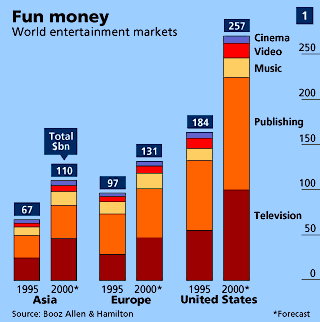
![]()
![]()
![]()
![]()
